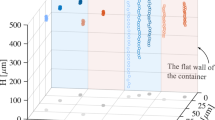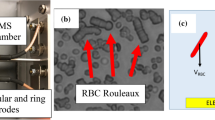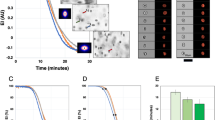Abstract
THE viscosity of blood is a complex physical property determined by many factors. These factors include at least: (a) the physical characteristics of the blood cells (size, shape, deformability, etc.); (b) the concentration of the blood cells; (c) the composition of the plasma (especially the proteins) and the interactions between plasma and cells; (d) the shear rate. To examine the influence of cell shape and deformability on blood viscosity, we have compared, at low shear rates, the viscosities of suspensions of red blood cells and suspensions of rigid, spherical latex particles with diameters comparable to the major diameters of red cells in human blood. Polystyrene latex (Dow Chemical Co., Midland, Michigan) used for this purpose consisted of rigid spheres, with a mean diameter of 9.2µ, suspended in water with soap and stabilized with colloidal silica. Human red blood cells are biconcave disks with a mean major diameter of 7.2µ (ref. 1) and are deformable2–4. In the work recorded here, plasma was removed from human blood and the cells washed and suspended in a protein-free solution (Ringer's solution), thus eliminating the influence of plasma proteins on blood viscosity and making the cell suspensions more comparable to the latex suspensions. Because of the dependence of the viscosity of cell suspensions on cell concentration and shear rate5,6, viscosity measurements on cell suspensions and latex suspensions were made over a wide range of particle concentration and at shear rates varying from 50 sec−1 to 0.02 sec−1.
This is a preview of subscription content, access via your institution
Access options
Subscribe to this journal
Receive 51 print issues and online access
$199.00 per year
only $3.90 per issue
Buy this article
- Purchase on Springer Link
- Instant access to full article PDF
Prices may be subject to local taxes which are calculated during checkout
Similar content being viewed by others
References
Altman, P. L., and Dittmer, D. S., (ed.), Biology Data Book (Fed. Amer. Soc. Exp. Biol., Washington, D.C., 1964).
Prothero, J. W., and Burton, A. C., Biophys. J., 2, 213 (1961).
Guest, M. M., Bond, T. P., Cooper, R. G., and Derrick, J. R., Science, 142, 1319 (1963).
Branemark, P. I., and Lindstrom, J., Biorheology, 1, 139 (1963).
Gregersen, M. I., Peric, B., Usami, S., and Chien, S., Proc. Soc. Exp. Biol. and Med., 112, 883 (1963).
Gregersen, M. I., Peric, B., Chien, S., Sinclair, D., Chang, C., and Taylor, H., Proc. IV Internat. Rheol. Cong. Symposium on Biorheol., 613 (John Wiley, N.Y., 1965).
Gillinson, jun., P. J., Dauwalter, C. R., and Merrill, E. W., Trans. Soc. Rheol., 7, 319 (1963).
Author information
Authors and Affiliations
Rights and permissions
About this article
Cite this article
TAYLOR, H., CHIEN, S., GREGERSEN, M. et al. Comparison of Viscometric Behaviour of Suspensions of Polystyrene Latex and Human Blood Cells. Nature 207, 77–78 (1965). https://doi.org/10.1038/207077a0
Issue Date:
DOI: https://doi.org/10.1038/207077a0
This article is cited by
-
Particle distribution for dilute suspension in flow
Bulletin of Mathematical Biology (1973)
-
Shear thickening phenomena in poly(vinyl)alcohol-borate complexes
Rheologica Acta (1968)
Comments
By submitting a comment you agree to abide by our Terms and Community Guidelines. If you find something abusive or that does not comply with our terms or guidelines please flag it as inappropriate.



